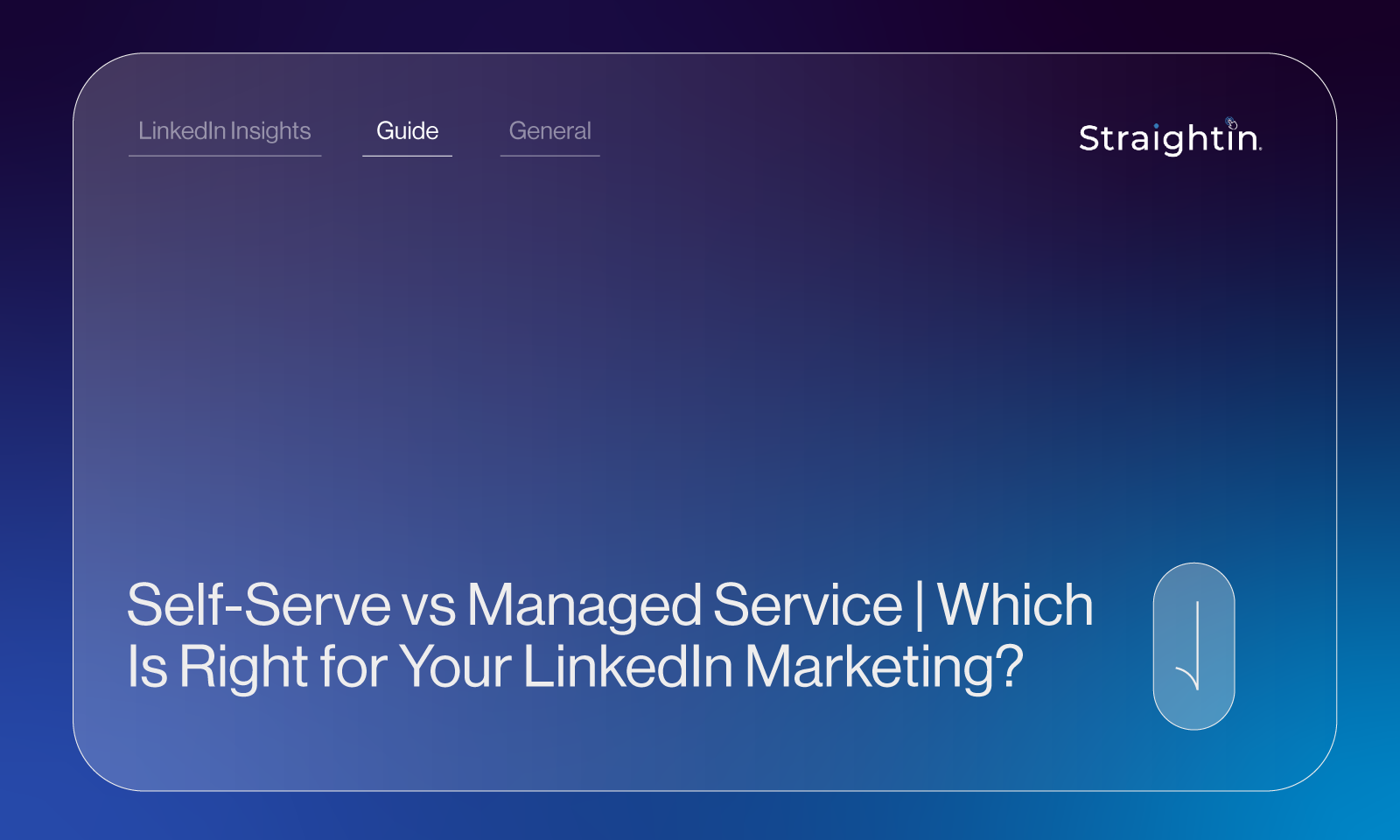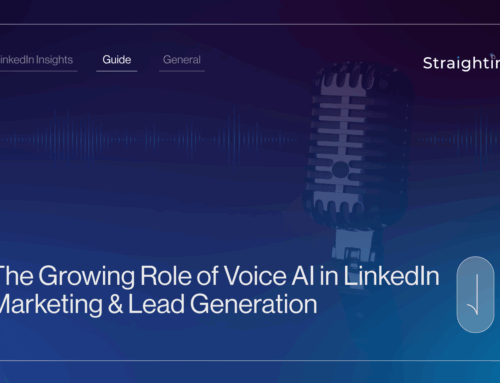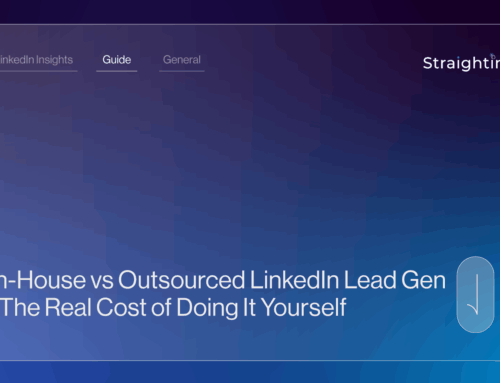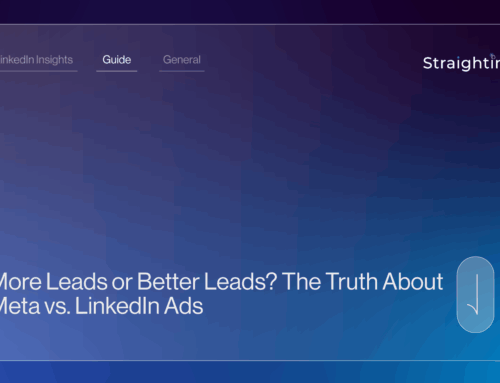LinkedIn marketing has become a key part of any B2B growth strategy. It is where decision-makers spend their time, where brands build authority, and where conversations turn into opportunities.
With more than a billion members and a growing focus on business content, LinkedIn has evolved far beyond a simple networking site. It’s now one of the most effective platforms for B2B lead generation, brand visibility, and LinkedIn outreach.
For companies looking to connect with the right audience, it offers an unmatched level of targeting. You can reach prospects based on job title, company size, industry, or even seniority, meaning your message lands directly in front of the people who actually matter. That’s why so many businesses, from startups to global enterprises, consider LinkedIn a critical part of their marketing mix.
But when it comes to LinkedIn marketing, the way you choose to manage your campaigns can make all the difference. There are two main ways of doing this:
- Some businesses prefer to keep things in-house with a self-serve approach, controlling every single detail from ad creative and targeting to budget and reporting.
- Others choose a managed service, partnering with LinkedIn specialists who handle the strategy, execution, and optimisation.
Both models can deliver excellent results, but they suit different needs. The right choice comes down to your goals, experience level, and the resources you have available.
Now, to be completely honest with you, as a specialist LinkedIn marketing agency with over six years of experience in lead generation, LinkedIn advertising, and content marketing (and, frankly, being pretty great at it), we do have a dog in this fight. But we’ll do our best to set our biases aside and give you a fair take. At least we will try…
Let’s break down how self-serve and managed service options work, including their pros and cons, so you can decide which model fits best for your business.
What is Self-Serve LinkedIn Marketing?
A self-serve model means your business takes full control of its LinkedIn marketing, managing everything in-house from lead generation and outreach to paid advertising and optimisation. It’s a hands-on approach that gives you total ownership of how you connect with prospects and promote your brand.
In practice, this usually involves two key tools: LinkedIn Sales Navigator and Campaign Manager.
Sales Navigator is your go-to for LinkedIn outreach, allowing you to find, filter, and message highly targeted prospects based on criteria like job title, seniority, industry, or company size. It’s ideal for building personal connections, starting conversations, and nurturing relationships directly within LinkedIn.
Then there’s Campaign Manager. The platform for LinkedIn advertising. This is where you can run and manage sponsored content, message ads, video campaigns, or lead gen forms. It gives you granular control over targeting, budget, and performance, enabling you to experiment with different ad formats and strategies to see what drives the best engagement or conversions.
The self-serve route offers freedom and visibility. You decide who to reach, what to say, and how much to spend, all without relying on external partners. It’s a great choice for businesses that already have marketing know-how, the time to test and learn, and a desire to build in-house expertise.
For more information on LinkedIn Sales Navigator, read some of our other blogs:
- Linkedin Premium vs Sales Navigator: What’s The Difference?
- LinkedIn’s Sales Navigator is Stepping Up Its Game with Generative AI
- Sales Navigator. Benefits, How it Works, and Best Practices
What are the Pros of Self-Serve?
Full control
You’re the pilot, co-pilot, and air traffic controller all in one. Every decision from ad creative and targeting to messaging, bidding, and budget allocation is entirely yours. You decide what gets tested, when campaigns launch, and how success is measured.
For marketers who know their audience and have experience running campaigns, this level of control can be both empowering and rewarding. You can move fast, make bold choices, and fine-tune strategies in real time.
Of course, that freedom comes with responsibility. Without the right experience or data to guide decisions, it can feel like flying blind (and LinkedIn isn’t exactly a cheap place to experiment.)
Direct relationships
Sales Navigator lets you take outreach into your own hands, personally connecting with decision-makers rather than relying on automated funnels or having others write your messages. This approach keeps your interactions human. You can send personalised messages that sound like you and build trust through genuine conversation.
Done well, it creates warmer leads, stronger relationships, and higher response rates than generic cold outreach.
Faster experimentation
The self-serve model gives you the agility to test, learn, and adapt fast. You don’t have to wait for agency sign-offs or lengthy approval chains.
Want to trial a new ad format, shift your targeting, or tweak your messaging mid-campaign? You can do it on the spot. That flexibility is gold in the B2B space, where market conditions, audience behaviour, and buying cycles can change quickly.
But that freedom cuts both ways because when you move fast without a clear strategy, it’s just as easy to make costly mistakes. A poorly timed test or a misjudged audience tweak can quickly drain the budget and set campaigns back weeks. Without structure or experience, experimentation can turn into guesswork and guesswork on LinkedIn can get expensive fast.
Hands-on learning
If your goal is to truly understand how LinkedIn works as a marketing engine, nothing beats doing it yourself. Managing campaigns firsthand helps your team grasp how Sales Navigator and Campaign Manager complement each other — one driving direct conversations, the other amplifying reach through paid ads.

You’ll gain valuable insight into what drives engagement, how LinkedIn’s bidding system shapes performance, and which types of creative and messaging truly resonate with your audience.
Many of our clients start out managing their own LinkedIn campaigns; and at first, they see some quick wins. But it doesn’t take long to realise just how complex and time-consuming it can be to do it well. The constant cycle of analysing data, tweaking targeting, refreshing creatives, and refining messaging soon turns what looked like a simple setup into a demanding, full-time job.
They quickly discover that while it’s possible to learn the mechanics, achieving consistent, scalable results requires a blend of strategy, experience, and ongoing optimisation — the kind that typically comes from working with specialists who live and breathe LinkedIn marketing every day. That’s usually the point they decide to call us.
Lower upfront costs
The self-serve route typically looks cheaper on paper. No agency or management fees mean more of your budget goes directly into ads, outreach tools, or content creation. For small businesses or startups testing the waters, that can be appealing.
But —and it’s an important but — “lower cost” doesn’t always mean “better value.”
Mistargeted campaigns, poor-quality leads, and inefficient optimisation can quickly eat into your budget. So, while the upfront spend is lower, the real cost often depends on how efficiently you manage and learn from your campaigns over time.
Cons of Self-Service
Time-intensive
Running LinkedIn campaigns is far from plug-and-play. Between building audiences, creating ads, refreshing creatives, analysing metrics, and managing outreach, it can easily consume hours each week.
For teams juggling multiple priorities, this can quickly become unsustainable, especially if you’re aiming for consistency and growth.
It’s a pattern we see often with new clients at StraightIn. Many start out managing their own campaigns and see some early success, but soon realise that sustaining momentum, optimising results, and scaling effectively demands far more time, tools, and expertise than they first expected.
Steep learning curve
LinkedIn’s ecosystem is powerful but complex. Without a clear strategy or experience, it’s easy to spend heavily without seeing results. Things like bidding strategies, audience overlap, and ad fatigue require constant attention. Similarly, creating personalised messages that convert (without sounding salesy) takes practice. The margin for error is narrow, and mistakes can be costly.
Limited strategic insight
You only have access to your own campaign data, which makes it harder to benchmark performance or identify untapped opportunities. Agencies and LinkedIn specialists work across dozens (in our case, hundreds) of accounts, giving them a wider view of what works across industries and audiences. Without that, it’s easy to miss valuable insights or repeat avoidable mistakes.
Risk of underperformance
Without consistent optimisation and testing, campaigns can quickly plateau. What performs well one quarter might underdeliver the next. Keeping ads fresh, audiences refined, and outreach relevant takes consistent effort. Without dedicated oversight, results can stagnate, and when that happens, LinkedIn’s cost-per-click can make underperformance expensive.
Potentially expensive in the long run
While self-serve marketing may seem budget-friendly at first, inefficiencies can rack up hidden costs. Poor targeting, untested messaging, or under-optimised campaigns lead to wasted spend.
Over time, this can make the “cheaper” option the more expensive one. As the saying goes, if you think hiring a professional is costly, try doing it wrong yourself.
Many businesses reach this point and start thinking, “Maybe we should just hire someone to handle it full-time.” It’s a thought we hear a lot from clients, and one that seems logical at first. But as Zac Hancox recently broke down, that move often turns out to be even more expensive in the long run.
Once you factor in salary, benefits, training, software, and downtime, bringing LinkedIn lead generation in-house becomes a significant investment, often without the same level of expertise, efficiency, or scalability that a specialist agency like StraightIn can offer.
It’s well worth a read if you want a deeper look at the true costs, time commitment, and performance differences between the two approaches. Read the full report below:
Summary of the Pros and Cons of Self-Serve LinkedIn Marketing
The self-serve model gives businesses full control over their LinkedIn marketing, making it an attractive option for experienced marketers who offer flexibility, faster experimentation, and lower upfront costs since there are no agency fees.

However, that freedom comes with challenges. Running campaigns effectively is time-intensive and demands ongoing optimisation, data analysis, and creative refreshes, often becoming a full-time job.
The learning curve is steep, and without experience in areas like bidding, targeting, and messaging, mistakes can quickly become costly. Self-serve marketers also lack strategic insight, as they have access only to their own data, unlike agencies, which draw on hundreds of campaigns to identify trends and best practices.
Without consistent testing and refinement, campaigns risk stagnating, leading to underperformance and wasted budget. While the approach may appear cheaper initially, hidden inefficiencies and missed opportunities often make it more expensive in the long run.
What is Managed Service?
A managed service means handing the reins of your LinkedIn marketing to a specialist via a dedicated LinkedIn marketing agency. Instead of managing campaigns yourself, you’re partnering with a team that lives and breathes the platform. These experts handle every stage of the process: from strategy, creative development, and targeting setup to optimisation, analytics, and performance reporting.
We like to think of it as having an entire marketing department on demand, one that knows the LinkedIn ecosystem inside and out. Managed service providers bring structure, proven frameworks, and years of campaign data to help you get results faster and more efficiently than starting from scratch.
At StraightIn, for instance, we don’t just set up campaigns. We act as a strategic extension of your business. We take the time to understand your brand, goals, and audience, ensuring your outreach, advertising, and content all work together to drive meaningful engagement and pipeline growth.
Pros of Managed Service
Expertise on tap
You gain instant access to a team that’s been there, done that, and optimised it a hundred times over. Managed service teams draw from experience across dozens (or in our case thousands) of campaigns in different industries, meaning they already know what works and what doesn’t. This includes everything from advanced audience segmentation and message sequencing to creative testing and algorithm insights that only come from hands-on experience.
At StraightIn, we’ve run campaigns for more than 4,000 clients across over 200 industries, covering nearly every B2B niche imaginable, from SaaS to biotech and everything in between. That means our team can draw on a wealth of proven insights to deliver results faster, smarter, and more efficiently, without the trial-and-error of doing it on your own.
Saves time
Outsourcing your LinkedIn marketing frees up your internal team to focus on what they do best — closing deals, nurturing leads, or managing other marketing channels. The day-to-day management of LinkedIn campaigns is handled for you. That means less time spent in dashboards and more time on strategy and results.
It also means getting campaigns live much faster, without all the second-guessing or back-and-forth that can slow things down. At StraightIn, we typically launch within 2 days to a week, depending on how quickly you want to move. Whether you want to move quickly or take a steadier approach, we’ll work at the pace that suits you best to make sure everything’s set up for success from day one.
Better performance
Managed service teams use data-driven strategies, enterprise-grade tools, and continuous optimisation to keep your campaigns performing at their best. They’re constantly monitoring trends, tweaking approaches, and running A/B tests to improve results week after week. Because they see what’s working across multiple industries, they can apply those insights directly to your campaigns, giving you an edge over competitors who are still figuring it out.
At StraightIn, that process is powered by teamwork. If something isn’t working, there’s always a group ready to step in and help. Here’s what that looks like in practice: real-time problem-solving rather than days of waiting, group brainstorming when a campaign needs a fresh creative angle, and regular campaign excellence sessions to keep performance sharp. We also share proven tactics across industries, so every client benefits from what’s working elsewhere. In short, you get a whole team backing your campaign, not just one person juggling everything.
Strategic partnership
A good managed service provider doesn’t just run ads or send connection requests. They become a trusted partner. They work closely with you to make sure your LinkedIn campaigns actively support your broader business objectives, ensuring your LinkedIn marketing supports your sales funnel, brand positioning, and long-term growth goals. With regular strategy calls, transparent reporting, and shared objectives, it’s a collaborative relationship that drives continuous improvement.
Cons of Managed Service
Management fees
The obvious trade-off is cost. Managed services involve agency or management fees, usually a fixed monthly investment, and any LinkedIn ad spend, if included. You’ll also still need your own access to tools like LinkedIn Sales Navigator and Campaign Manager, since they’re tied to your personal or company account. That said, this is often offset by stronger ROI, since better targeting, higher-quality leads, and ongoing optimisation usually deliver more value than what’s lost to inefficiencies in self-serve campaigns.
At StraightIn, for example, our average cost per lead is around £50, not a bad return for the quality and consistency we deliver, if we do say so ourselves.
Less hands-on control
When you outsource, you’re trusting a team of specialists to manage campaigns on your behalf. That means you won’t be the one pulling every lever or making every amendment. For some businesses, that can feel like a loss of control, especially when outreach is happening through your own or your employees’ LinkedIn profiles. We get it. That can be daunting.
But in reality, a good managed service partner keeps you fully in the loop. You’ll stay involved in key decisions while they handle the strategy, execution, and day-to-day management behind the scenes. The key is choosing the right partner that’s transparent, communicative, and treats your brand as carefully as their own.
For reference, at StraightIn, we hold weekly meetings during the initial onboarding phase, then move to bi-weekly once campaigns are running smoothly. We also encourage setting up dedicated Slack channels so clients can stay updated in real time. And if your account manager is on holiday or out of the office, another team member steps in to make sure your campaigns continue ticking along.
We have found that this level of communication and consistency builds real trust with our clients. It ensures campaigns don’t lose momentum, questions are answered quickly, and everyone stays on the same page about performance and next steps. Ultimately, that partnership mindset is what makes managed service work.
Dependence on communication
The success of a managed service depends heavily on collaboration. Your provider will rely on regular updates, feedback, and access to insights from your business to fine-tune campaigns effectively. Strong two-way communication keeps everything on track, ensuring your campaigns reflect your goals, brand voice, and overall direction.
Summary of the Pros and Cons of Managed Service
The main advantages of a managed service approach are expertise, time savings, and performance. You gain access to professionals who know LinkedIn inside out and use cross-industry insights to refine your campaigns.
It also frees up your internal team to focus on other priorities while experts manage the day-to-day work, ensuring continuous optimisation and stronger ROI through better targeting, testing, and messaging.
Of course, this comes at a cost. Managed services involve agency fees on top of your Sales Navigator and Campaign Manager subscriptions, and you’ll be trusting a team to manage campaigns on your behalf.

Success ultimately depends on strong communication. With regular updates and collaboration, managed service becomes more than just outsourcing. It’s a partnership designed to deliver sustainable growth without the stress or steep learning curve of doing it all yourself.
Which Model Should You Choose for Your LinkedIn Marketing?
Ultimately, the right approach depends on your resources, experience, and priorities.
Go self-serve if you already have a capable in-house marketing team with the time, tools, and expertise to manage campaigns proactively. This model works best when you can dedicate consistent attention to building audiences, testing creatives, refining messaging, and analysing performance.
But one important caveat: it’s not a one-person job.
Running successful LinkedIn campaigns requires ongoing effort across strategy, content, and optimisation, which can be difficult for small teams juggling other priorities.
If your marketing person is already juggling LinkedIn, email, social media, PPC, and the countless other tasks that come with the role, then adding self-serve LinkedIn marketing to their list probably isn’t the best move.
Go managed service if you want expert-led campaigns that deliver predictable, measurable results without the daily workload. A specialist LinkedIn agency brings experience, frameworks, and technology that can accelerate performance far beyond what most internal teams can achieve on their own. You’ll gain access to data-backed insights, tested outreach strategies, and optimisations informed by hundreds of campaigns across industries, all while freeing your team to focus on sales, client relationships, and other strategic goals.
The most important thing, though, is choosing the right partner. Not every agency works the same way. Look for a team that’s transparent, communicative, and truly understands how LinkedIn fits into your wider business objectives, not just one that promises quick wins or vanity metrics.
The right managed partner will feel like an extension of your business, combining expertise with collaboration to turn your LinkedIn presence into a consistent source of growth and opportunity.
The Honest Truth About Self-Serve vs Managed Service
Alright, we said at the start we’d try to be unbiased—and we really did try, honestly—but the truth is, whether you choose to go self-serve or managed service, the ultimate goal is the same — to turn LinkedIn into a reliable engine for growth, brand authority, and high-quality conversations with the people who matter most.
If you have the time, tools, and expertise in-house, self-serve can be a great way to stay hands-on and build internal capability. But for most businesses, a managed service unlocks far greater efficiency, consistency, and performance.
With the right partner, you get not just execution but strategy, creativity, and insight that help you cut through the noise and deliver real results.
At StraightIn, we specialise in Outreach Marketing, LinkedIn Advertising, Content Marketing, and Personal Branding, combining proven strategies with hands-on support to help you stand out on LinkedIn and connect with the right audience. Our team lives and breathes LinkedIn marketing, optimising every detail to turn conversations into opportunities and campaigns into pipelines.
If you’re ready to see how a specialist partner can strengthen your LinkedIn presence and drive measurable growth, get in touch with us today. Call 0161 518 4740, or email grow@straight-in.co.uk.







